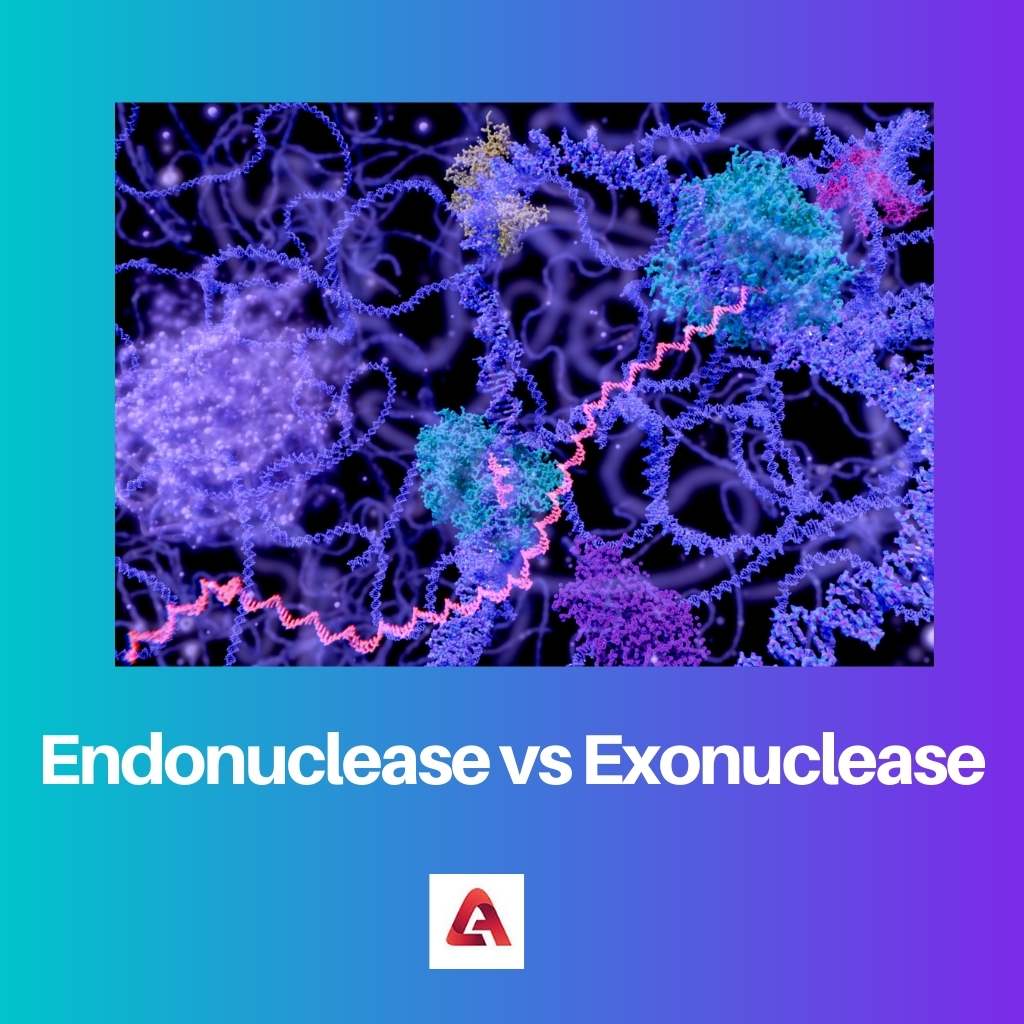Nucleases play an indispensable role in recombinant DNA technology, genetics, and genetic engineering. Because of their ability to cut DNA segments, nucleases have various practical applications.
Key Takeaways
- Endonucleases cleave DNA at specific internal sites, while exonucleases remove nucleotides from the ends of DNA or RNA molecules.
- Endonucleases play a crucial role in DNA repair and recombination, whereas exonucleases participate in DNA replication and proofreading.
- Restriction enzymes are examples of endonucleases, while DNA polymerase I am an example of an exonuclease.
Endonuclease vs Exonuclease
Endonuclease cut the DNA or RNA by recognizing the specific location within the nuclei acid chain. The ability of endonuclease to cleave precisely is useful in many biological processes. Exonuclease degrades DNA or RNA from the ends of the nuclei acid chain and it is helpful in cellular processes.

Its function is to cut the DNA segment at its recognition site. More importantly, endonuclease enzymes cut the DNA segment from the inner side.
The most vital application of exonuclease is to assist in DNA repair. More importantly, exonuclease enzymes cut DNA segments from the ends.
Comparison Table
| Parameters of Comparison | Endonuclease | Exonuclease |
|---|---|---|
| Definition | Endonuclease refers to the group of enzymes that cut the DNA segments from the inner side. | Exonuclease refers to the group of enzymes that cut the DNA segment from the ends. |
| Lag Period | Like the restriction endonuclease, endonucleases experience a lag period before carrying out their specific task. | In exonucleases, there is an absence of a lag period before the commencement of their specific task. |
| Results In | The cleaving of DNA segments results in oligonucleotides. | The cleaving of DNA segments results in nucleosides. |
| Function | Endonuclease enzymes play a role in defence as they prevent the entry of pathogens. | Exonucleases lack any defensive functions. |
| Free Ends | Endonuclease enzymes don’t require free 3’, and 5’ ends to perform their functions. | Exonucleases require free ends for the commencement of their specific tasks. |
What is Endonuclease?
Endonuclease refers to the group of enzymes found within the polynucleotide chain which cleave the phosphodiester bond. Some endonuclease enzymes, for instance, deoxyribonuclease I, cut the Deoxyribonucleic acid without any regard to sequence.
One of the most vital groups of endonucleases is the restriction enzymes. The restriction enzymes have three categories based on their action mechanism: Type I, Type II, and Type III.
Bacterial cells are the natural source of restriction endonuclease. Moreover, the ends of endonucleases are either blunt or sticky. An example of a famous endonuclease is Cas9.
Endonucleases are vital for several reasons. However, one of the more prominent reasons is their ability to repair damaged DNA cells precisely.
What is Exonuclease?
Exonucleases refer to the group of enzymes that function by cutting nucleotides one at a time from the Exo (end) of a polynucleotide chain. These enzymes cut the nucleotide from either the 3’ or the 5’ at one specific time. Additionally, exonuclease serves as a hydrolyzing enzyme.
Exonuclease is found in humans, bacteria, animals, and insects. Interestingly, the venom of lizards and snakes consists of exonuclease enzymes.
Exonuclease enzymes play a vital role in cellular metabolism and maintenance. Moreover, they are crucial aspects of genome stability as they cut the DNA from free ends. Exonucleases may also have a part in repairing damaged DNA cells.
In the case of exonuclease enzymes, the lag period is absent before activity. Conclusively, exonucleases are a group of enzymes serving multi-facet functions.
Main Differences Between Endonuclease and Exonuclease
- Like the restriction endonuclease, endonucleases experience a lag period before carrying out their specific task. On the other hand, in exonucleases, the lag period is absent before the commencement of their specific task.
- Endonuclease enzymes don’t require free 3’, and 5’ ends to perform their functions. In contrast, exonucleases require free ends for the commencement of their specific tasks.



